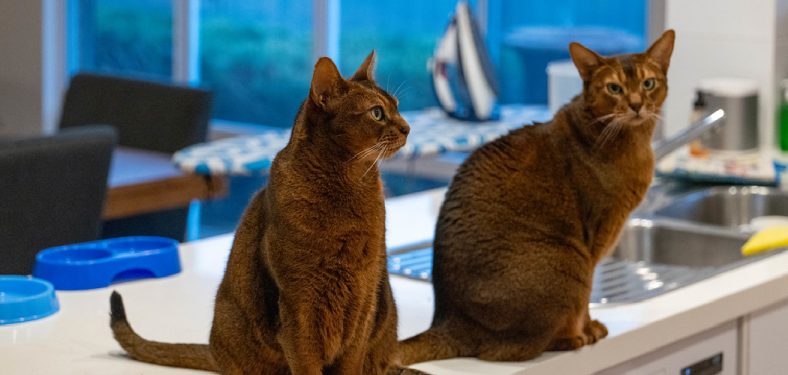Cats are amazing creatures, and we love them dearly, but sometimes they can be a real pain regarding our possessions. Cabinets are one of the biggest targets for cats since they’re easily accessible and provide a lot of interesting nooks and crannies to explore. In this post, we’ll discuss how to cat proof cabinets so that your feline friend doesn’t cause too much damage.
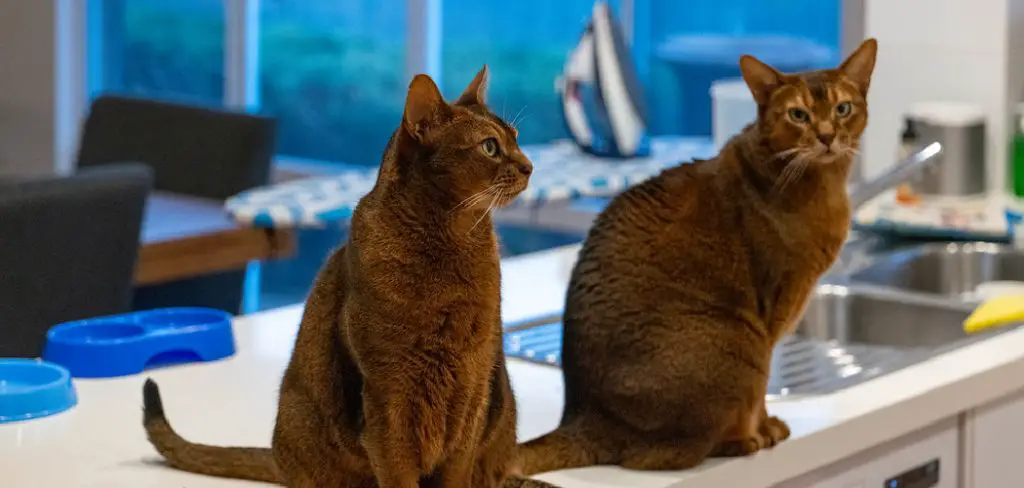
Contents
Why Should You Cat Proof Cabinets?
If you’re a cat lover, you know cats are curious creatures. They like to explore their surroundings and often find themselves in places they’re not supposed to be. This can pose a problem if your home has cabinets full of dangerous chemicals or sharp objects.
That’s why it’s important to cat-proof your cabinets to keep your furry friend safe. One way to do this is to install child-proof locks on all your cabinets. This will prevent your cat from getting into any trouble. You can also try placing upside-down metal hooks inside your cabinet doors.
This will create a barrier that your cat can’t get through. But, by taking these simple steps, you can rest assured that your cat will stay safe and sound.
6 Tips to Follow on How to Cat Proof Cabinets
If you have a cat, you know how much they love to explore. And that means they might be tempted to jump onto your kitchen countertops to check out what’s cooking. One way to prevent your cat from getting into mischief is to cat proof your cabinets. Here are a few tips on how to do that:
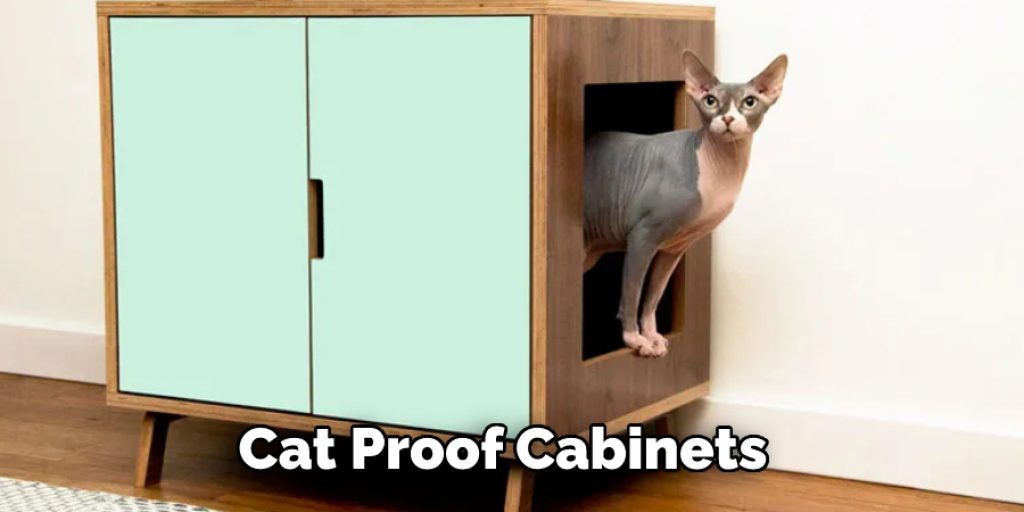
1. Put Double-Sided Tape
This is a great way to deter your cat from jumping on countertops and getting into cabinets. All you need to do is put some double-sided tape on the edge of the counter or cabinet door. Your cat will not like the feel of the sticky tape on its paws and will avoid it.
2. Use Sticky Pads
You can use double-sided sticky pads to help keep your cat away from certain areas, like cabinets. Just place the pads outside the cabinet doors, and your cat will likely stay away. You can also try using foil.
3. Keep Things Out of Reach
If there are items in your cabinets that you don’t want your cat to get into, it’s important to keep them out of reach. One way to do this is to use cabinet locks or childproof latches. This will ensure that curious kitties or cats can’t get into trouble.
4. Use Cat deterrent Sprays
There are many commercial cat deterrent sprays available that can effectively keep cats away from cabinets. These sprays usually contain an unpleasant scent or taste that will deter cats from approaching the sprayed area. Be sure to follow the instructions on the package carefully, and re-apply the spray as needed to maintain its efficacy.
5. Create a Cat-Friendly Space
If you have a cat, it’s important to create a space just for them. This can help deter them from getting into places they’re not supposed to be. Consider setting up a cat tree near your cabinets or placing some cat toys on the countertop. This will give your cat a place to play and explore without getting into trouble.
6. Be Consistent
It’s important to be consistent with your cat-proofing efforts. If you allow your cat on the countertop sometimes, they will likely try to get up there more often. It’s best to be consistent in your efforts to keep them off of off-limits surfaces.
That’s it! You’ve now learned how to cat proof cabinets. By following these tips, you can help keep your cat safe and prevent them from getting into places they’re not supposed to be.
Why You Need to Cat Proof Your Cabinets
Cats are notorious for getting into things they’re not supposed to. So when exploring your home, cabinets are one of their favorite targets. Not only do cabinets provide a warm, dark place to hide, but they also offer a treasure trove of interesting things to play with.
If you have cats, it’s important to cat-proof your cabinets. This means making sure that the cabinet doors are securely latched and that any poisonous or dangerous items are out of reach.
By taking these simple precautions, you can help keep your cats safe and prevent costly repairs to your cabinets.
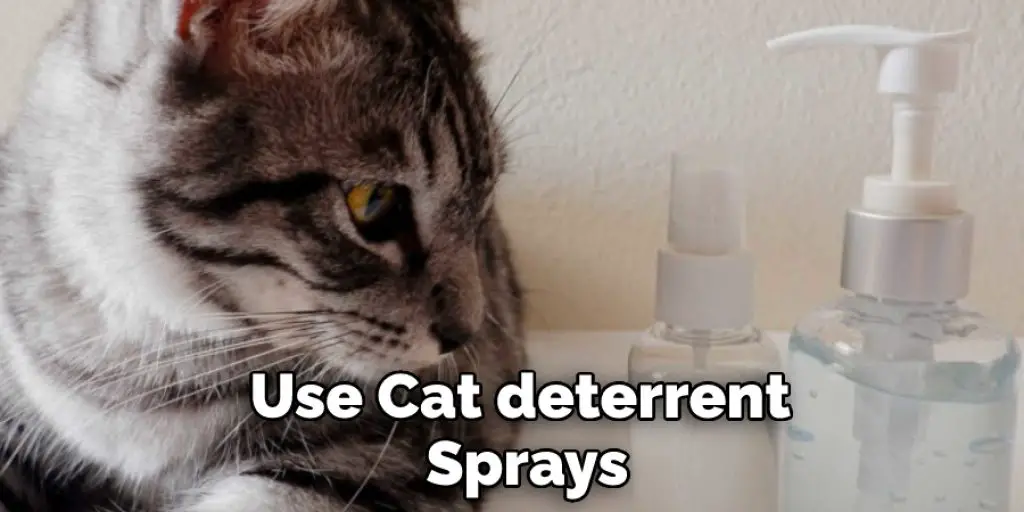
How to Keep Kitties out of the Kitchen
We all know that cats are curious creatures. They like to explore every nook and cranny of our homes, and the kitchen is often one of their favorite places to hang out. But unfortunately, the kitchen can also be a dangerous place for cats. Kitchen appliances and sharp utensils can seriously threaten your feline friend, and the risk of accidental poisoning is always present.
So, how can you keep your cat out of the kitchen? One effective method is to create a designated “cat zone” in another room of your house. Fill this space with your kitty’s favorite toys and scratching post, and ensure there’s always a fresh water bowl.
You should also put a sign on the door leading to the kitchen, letting your cat know this is off-limits. Then, with patience and perseverance, you can successfully keep your cat out of the kitchen and away from harm.
What Kind of Materials Can Be Used to Make Cabinets Cat Proof?
When it comes to making cabinets cat-proof, there are a few different options. One material that is often used is clear vinyl. This material is durable and can be easily wiped down, making it ideal for protecting cabinets from scratches.
Another option is to use a product like Formica, which is scratch resistant. Finally, many people opt for stainless steel cabinets, as they are tough and easy to clean.
Whichever material you choose, take the time to seal the cabinets to prevent any unwanted accidents properly. Keep reading for more information about how to cat proof cabinets.
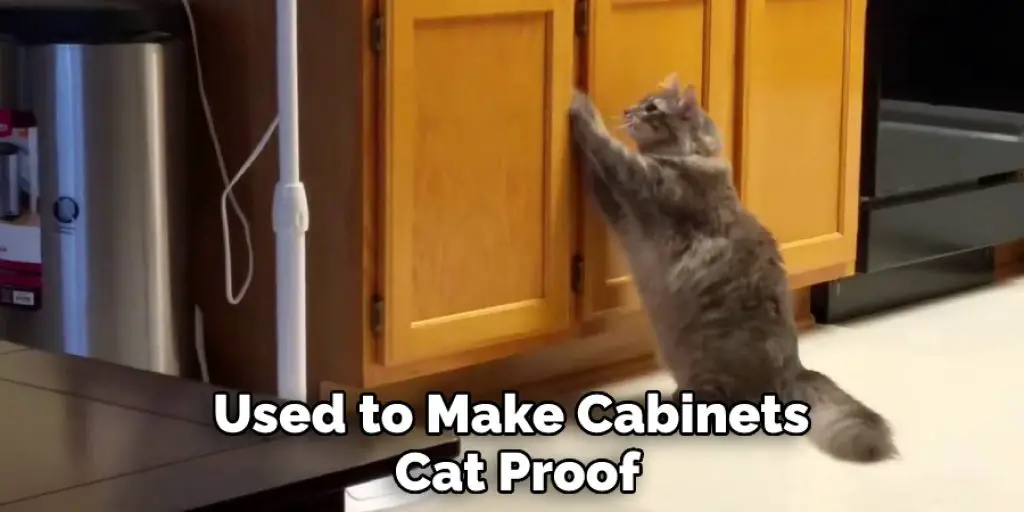
What Are Some Tips for Cat Proofing My Cabinets?
If you have a cat, you know they like to get into everything. Cabinets are no exception. Here are some tips for catproofing your cabinets:
1. Install childproof locks on all cabinets, especially those containing hazardous materials or cleaning supplies.
2. Put mats or nonslip rug runners in front of cabinets to prevent your cat from slipping and getting hurt.
3. Place deterrents like double-sided tape or aluminum foil inside cabinets to deter your cat from going in there.
4. Store food and other items your cat might be attracted to in sealed containers or high up where they can’t reach them.
Following these tips will help keep your cat safe and out of your cabinets!
Why Does My Cat Dig in My Drawers?
Cats are creeps. They’re always lurking around, watching us with those beady little eyes. We can never be sure what they’re thinking. And when they start digging through our things, it’s even creepier. But why do they do it?
There are a few reasons. For one, cats like to mark their territory. They have scent glands in their paws, and when they scratch things, they leave behind a small amount of their scent. This helps them feel more comfortable in their environment and lets other cats know that this is their territory.
Additionally, digging through our things gives them a sense of control. Their world is constantly changing – new furniture gets added, people come and go – and by digging through our things, they can exert some control over their environment and make it feel more familiar.
Finally, cats are curious creatures, and our drawers are full of interesting things for them to explore – not to mention the fact that we often have food hidden away in there!
So next time your cat starts digging through your things, don’t get too creeped out – they’re just doing what comes naturally to them.
Frequently Asked Question
Do Cats Hate Aluminum Foil?
Some cats may be repelled by aluminum foil, as it has a metallic smell. You can try lining the cabinet shelves with foil to see if your cat avoids them. If it seems to work, keep the foil in place and replace it as needed.
What Smell Do Cats Hate?
The answer to this question is citrus. Cats have a natural aversion to citrus smells. You can use this to your advantage when cat-proofing cabinets. Simply place a few orange or lemon peels in the cabinets to deter your cat from entering.

What Won’t Cats Walk On?
One of the ways to cat-proof your cabinets is to put up a barrier that they won’t be able to walk or jump over. You can do this by using a baby gate or a piece of furniture too high for them to jump onto.
Conclusion
Cats are curious creatures by nature, and often they will want to explore cabinets in your home. While it’s important to make sure your cabinets are cat-proofed, there are a few things you can do to make the process easier. Thanks for reading our post about how to cat proof cabinets. By following these tips, you’ll have peace of mind knowing that your kitty is safe and sound – and out of trouble!

